Inelastic demand ans - Study guides, Class notes & Summaries
Looking for the best study guides, study notes and summaries about Inelastic demand ans? On this page you'll find 40 study documents about Inelastic demand ans.
Page 4 out of 40 results
Sort by
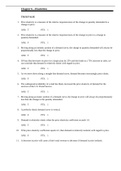
-
ECON 301-Chapter 6—Elasticities. Questions and Answers
- Exam (elaborations) • 39 pages • 2021
- Available in package deal
-
- $10.99
- + learn more
ECON 301-Chapter 6—Elasticities. Questions and Answers TRUE/FALSE 1. Price elasticity is a measure of the relative responsiveness of the change in quantity demanded to a change in price. ANS: T PTS: 1 2. Price elasticity is a measure of the relative responsiveness of the change in price to a change in quantity demanded. ANS: F PTS: 1 3. Moving along an inelastic portion of a demand curve, the change in quantity demanded will always be proportionally less than the change in price. A...
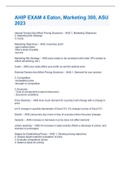
-
2023 AHIP EXAM 4 Eaton, Marketing 300, ASU
- Exam (elaborations) • 10 pages • 2022
-
Available in package deal
-
- $18.99
- + learn more
Internal Factors that Affect Pricing Decisions - ANS 1. Marketing Objectives 2. Marketing Mix Strategy 3. Costs Marketing Objectives - ANS -maximize profit -gain market share -infer a level of quality -survive Marketing Mix Strategy - ANS price needs to be consistent with other 3P's (needs to reflect advertising, etc.) Costs - ANS your costs affect your profit, so set the optimal price External Factors that Affect Pricing Decisions - ANS 1. Demand for your product 2. Co...
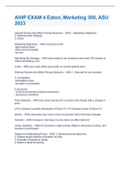
-
2023 AHIP EXAM 4 Eaton, Marketing 300, ASU
- Exam (elaborations) • 10 pages • 2022
-
Available in package deal
-
- $18.99
- + learn more
Internal Factors that Affect Pricing Decisions - ANS 1. Marketing Objectives 2. Marketing Mix Strategy 3. Costs Marketing Objectives - ANS -maximize profit -gain market share -infer a level of quality -survive Marketing Mix Strategy - ANS price needs to be consistent with other 3P's (needs to reflect advertising, etc.) Costs - ANS your costs affect your profit, so set the optimal price External Factors that Affect Pricing Decisions - ANS 1. Demand for your product 2. Co...
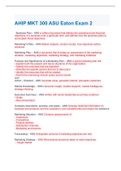
-
AHIP EXAM 4 Eaton, Marketing 300, ASU 2023
- Exam (elaborations) • 7 pages • 2022
-
- $18.49
- + learn more
AHIP EXAM 4 Eaton, Marketing 300, ASU Internal Factors that Affect Pricing Decisions - ANS 1. Marketing Objectives 2. Marketing Mix Strategy 3. Costs Marketing Objectives - ANS -maximize profit -gain market share -infer a level of quality -survive Marketing Mix Strategy - ANS price needs to be consistent with other 3P's (needs to reflect advertising, etc.) Costs - ANS your costs affect your profit, so set the optimal price External Factors that Affect Pricing Decisions -...
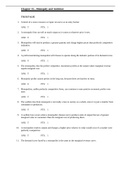
-
ECON 301-Chapter 13—Monopoly and Antitrust . Questions and Answers
- Exam (elaborations) • 36 pages • 2021
- Available in package deal
-
- $9.99
- + learn more
ECON 301-Chapter 13—Monopoly and Antitrust . Questions and Answers TRUE/FALSE 1. Control of a scarce resource or input can serve as an entry barrier. ANS: T PTS: 1 2. A monopoly firm can sell as much output as it wants at whatever price it sets. ANS: F PTS: 1 3. Monopolies will tend to produce a greater quantity and charge higher prices than perfectly competitive industries. ANS: F PTS: 1 4. A profit-maximizing monopolist will choose to operate along the inelastic portion of its dem...
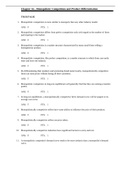
-
ECON 301-Chapter 14—Monopolistic Competition and Product Differentiation. Questions and Answers
- Exam (elaborations) • 30 pages • 2021
- Available in package deal
-
- $9.99
- + learn more
ECON 301-Chapter 14—Monopolistic Competition and Product Differentiation. Questions and Answers TRUE/FALSE 1. Monopolistic competition is more similar to monopoly than any other industry model. ANS: F PTS: 1 2. Monopolistic competition differs from perfect competition only with regard to the number of firms participating in the market. ANS: F PTS: 1 3. Monopolistic competition is a market structure characterized by many small firms selling a homogeneous product. ANS: F PTS: 1 4. Mo...
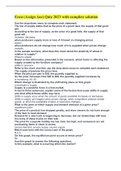
-
Econ (Assign Ans) Quiz 2023 with complete solution
- Exam (elaborations) • 2 pages • 2023
-
- $9.49
- + learn more
Econ (Assign Ans) Quiz 2023 with complete solution Use the drop-down menu to complete each statement. The law of supply states that as the price of a good rises, the supply of that good will . According to the law of supply, as the price of a good falls, the supply of that good will . increase, decrease when producers supply more or less of it based on changing prices. elastic when producers do not change how much of it is supplied when prices change. inelastic In the sample scenario,...
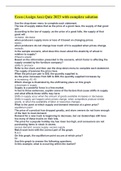
-
Econ (Assign Ans) Quiz 2023 with complete solution
- Exam (elaborations) • 2 pages • 2023
-
- $9.49
- + learn more
Econ (Assign Ans) Quiz 2023 with complete solution Use the drop-down menu to complete each statement. The law of supply states that as the price of a good rises, the supply of that good will . According to the law of supply, as the price of a good falls, the supply of that good will . increase, decrease when producers supply more or less of it based on changing prices. elastic when producers do not change how much of it is supplied when prices change. inelastic In the sample scenario,...
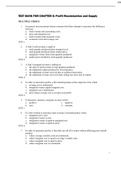
-
Eco 3100 all chapters
- Exam (elaborations) • 48 pages • 2022
-
- $5.59
- + learn more
In general, microeconomic theory assumes that firms attempt to maximize the difference between a. total revenue and accounting costs. b. price and marginal cost. c. total revenues and economic costs. d. economic costs and average cost. ANS: c 2. A firm’s total revenue is equal to a. total quantity produced times marginal cost. b. total quantity produced times market price. c. marginal revenue times total quantity produced. d. market price divided by total quantity produced. ANS: b ...
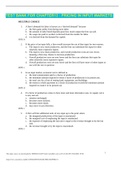
-
TEST BANK FOR CHAPTER 13 : PRICING IN INPUTS MARKETS
- Exam (elaborations) • 8 pages • 2022
-
- $7.49
- + learn more
MULTIPLE CHOICE 1. A firm’s demand for labor is known as a “derived demand” because a. the firm gains utility from hiring more labor. b. the amount of labor hired depends upon how much output the firm can sell. c. the wage rate paid to workers is derived from the market for labor. d. it is derived from the demand for capital. ANS: b 2. If the price of an input falls, a firm would increase the use of that input for two reasons: a. The input is now more productive, and the firm can s...

Do you wonder why so many students wear nice clothes, have money to spare and enjoy tons of free time? Well, they sell on Stuvia! Imagine your study notes being downloaded a dozen times for $15 each. Every. Single. Day. Discover all about earning on Stuvia


